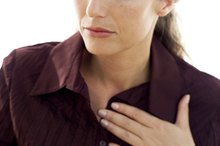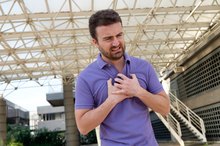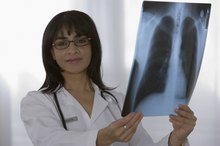Causes of Burning Pain in the Chest & Back
Burning pain in the chest and back can be a symptom of a serious medical condition and requires evaluation by a doctor. The chest contains a number of different organs, so pain in the chest and back can be indicative of disorders in several possible organs, including the heart, aorta, lungs and esophagus. Burning chest and back pain may also be caused by musculoskeletal or nerve disorders.
Heart Conditions
Some of the most serious causes of chest and back pain involve the heart. Heart pain -- either angina or a heart attack -- resulting from inadequate blood flow to the heart muscle because of coronary artery disease typically occurs in the chest. It may also be felt in the left arm, neck, and upper back. The pain often feels like a pressure or heaviness, but it sometimes feels like burning. Other symptoms of a heart attack may include nausea, vomiting, sweating, heart palpitations, shortness of breath, lightheadedness or fainting. Pericarditis -- inflammation of the sac around the heart -- or myocarditis -- inflammation of the heart muscle itself -- are less common causes of burning chest and back pain.
- Some of the most serious causes of chest and back pain involve the heart.
- Pericarditis -- inflammation of the sac around the heart -- or myocarditis -- inflammation of the heart muscle itself -- are less common causes of burning chest and back pain.
Aortic Dissection or Rupture
Why Does the Right Side of Your Chest Hurt?
Learn More
The aorta is the large artery that leads blood from the heart to the rest of the body. It runs from the heart, through the chest and into the abdomen, where it divides into two arteries that enter the legs. Dissection or rupture of the aorta in the chest -- called the thoracic aorta -- can cause burning chest and upper back pain. In aortic dissection, the inner layer of the artery tears away from the rest of the vessel wall. This causes the artery to balloon outward and possibly burst, or rupture. Aortic rupture may also occur for other reasons, such as a major chest injury due to a car accident. Aortic dissection and rupture can be fatal and require immediate medical attention.
- The aorta is the large artery that leads blood from the heart to the rest of the body.
- Dissection or rupture of the aorta in the chest -- called the thoracic aorta -- can cause burning chest and upper back pain.
Lung Disorders
Pneumonia is one of the most common lung conditions causing chest and back pain. It is an infection of the lung caused by viruses, bacteria or fungi. Shortness of breath, coughing and fever are other common symptoms of pneumonia. Pleuritis -- inflammation of the sac surrounding each lung -- can also cause burning chest and back pain, which is typically worse when taking a deep breath or coughing. Pleuritis can be caused by pneumonia, but pleuritis may also occur on its own.
A blood clot in the lung -- called a pulmonary embolism -- can produce chest and upper back pain, which may feel like a burning sensation. It is usually accompanied by shortness of breath and coughing and can be life-threatening. Pulmonary embolism often originates from a blood clot in a leg vein, known as a deep vein thrombosis (DVT), that breaks free and travels to the lungs through the bloodstream.
- Pneumonia is one of the most common lung conditions causing chest and back pain.
- A blood clot in the lung -- called a pulmonary embolism -- can produce chest and upper back pain, which may feel like a burning sensation.
Esophagus Conditions
Stomach Aches & Back Pain
Learn More
The esophagus is the passageway transporting liquids and solids from the mouth to the stomach. Disorders of the esophagus can cause chest and back pain that often feels like burning. In gastroesophageal reflux disease (GERD), acid moves from the stomach up into the esophagus, causing inflammation of the esophagus and heartburn pain. Spasm of the esophagus, characterized by abnormal contractions of the muscles in the wall of the esophagus, is another cause of burning pain in the chest and back. Difficulty swallowing liquids or food is often present as well. Less commonly, chest and back pain is caused by an infection in the esophagus. This occurs primarily in people with a weakened immune system, such as people with AIDS or receiving treatment for cancer.
- The esophagus is the passageway transporting liquids and solids from the mouth to the stomach.
- Less commonly, chest and back pain is caused by an infection in the esophagus.
Musculoskeletal and Nerve Disorders
Some musculoskeletal disorders affecting bones, cartilage, joints, muscles or ligaments may also cause pain in the chest and back. Costochondritis is a disorder caused by inflammation of rib cartilage, usually where the ribs connect to the breastbone. It causes pain in the front of the chest that may be burning and may extend into the back or even the abdomen.
Disorders affecting nerves typically produce pain that feels like a burning sensation. When nerves supplying the chest and back are affected, pain will be felt in these areas. Shingles, or herpes zoster, is caused by reactivation of the chickenpox virus, generally in older persons. In this condition the virus travels along a nerve, producing pain and a blister-like rash along the nerve path.
- Some musculoskeletal disorders affecting bones, cartilage, joints, muscles or ligaments may also cause pain in the chest and back.
- Costochondritis is a disorder caused by inflammation of rib cartilage, usually where the ribs connect to the breastbone.
Seeking Medical Attention
See your doctor if you have pain in the chest and back to determine the cause. Seek immediate medical care if the pain is severe, begins suddenly, is getting progressively worse or is accompanied by other symptoms such as shortness of breath, palpitations, sweating, lightheadedness or fainting.
Reviewed by Mary D. Daley, MD
Related Articles
References
- Merck Manual Professional Version: Herpes Zoster (Shingles; Acute Posterior Ganglionitis)
- Merck Manual Professional Version: Chest Pain
- Merck Manual Professional Version: Symptomatic Diffuse Esophageal Spasm (Spastic Pseudodiverticulosis; Rosary Bead or Corkscrew Esophagus)
- Rao SS. Diagnosis and management of esophageal chest pain. Gastroenterol Hepatol (N Y). 2011;7(1):50-2.
- National Heart, Lung, and Blood Institute. Venous Thromboembolism Also Known as Blood Clots, Deep Vein Thrombosis (DVT), Pulmonary Emoblism (PE).
- Suarez N, Conway N, Pickett T. Panic-related hyperventilation resulting in hypophosphataemia and a high lactate. BMJ Case Rep. 2013;2013:bcr2013009307. doi:10.1136/bcr-2013-009307
- Yelland MJ. (2018). Outpatient evaluation of the adult with chest pain. Aronson MD, ed. UpToDate. Waltham, MA: UpToDate Inc.
- Bordoni B, Marelli F, Morabito B, Castagna R. Chest pain in patients with COPD: the fascia's subtle silence. Int J Chron Obstruct Pulmon Dis. 2018;13:115. doi:10.2147/COPD.S156729
- Rao SS. Diagnosis and management of esophageal chest pain. Gastroenterol Hepatol (N Y). 2011;7(1):50-2.
- National Heart, Lung, and Blood Institute. Venous Thromboembolism Also Known as Blood Clots, Deep Vein Thrombosis (DVT), Pulmonary Emoblism (PE).
- Ryu S, Fu W, Petri MA. Associates and predictors of pleurisy or pericarditis in SLE. Lupus Sci Med. 2017;4(1):e000221. doi:10.1136/lupus-2017-000221
- Choi WI. Pneumothorax. Tuberc Respir Dis (Seoul). 2014;76(3):99-104. doi:10.4046/trd.2014.76.3.99
- Neumann V, Löseke S, Nowak D, Herth FJ, Tannapfel A. Malignant pleural mesothelioma: incidence, etiology, diagnosis, treatment, and occupational health. Dtsch Arztebl Int. 2013;110(18):319-26. doi:10.3238/arztebl.2013.0319
- Lin K, Tung C. Integrating Acupuncture for the Management of Costochondritis in Adolescents. Med Acupunct. 2017;29(5):327-330. doi:10.1089/acu.2017.1233
- Ayloo A, Cvengros T, Marella S. Evaluation and treatment of musculoskeletal chest pain. Prim Care. 2013;40(4):863-87, viii. doi:10.1016/j.pop.2013.08.007
- Orthopaedics and Sports Medicine. University of Washington Medicine. Ankylosing Spondylitis.
- Lu L, Liu M, Sun R, Zheng Y, Zhang P. Myocardial Infarction: Symptoms and Treatments. Cell Biochem Biophys. 2015;72(3):865-7. doi:10.1007/s12013-015-0553-4
- Kim HJ, Lee HK, Cho B. A case of acute aortic dissection presenting with chest pain relieved by sublingual nitroglycerin. Korean J Fam Med. 2013;34(6):429-3. doi:10.4082/kjfm.2013.34.6.429
- Cleveland Clinic. Pericarditis. 2019.
- Gaude GS. Pulmonary manifestations of gastroesophageal reflux disease. Ann Thorac Med. 2009;4(3):115-23. doi:10.4103/1817-1737.53347
- Grossi L, Ciccaglione AF, Marzio L. Esophagitis and its causes: Who is "guilty" when acid is found "not guilty"? World J Gastroenterol. 2017;23(17):3011-3016. doi:10.3748/wjg.v23.i17.3011
- Suarez N, Conway N, Pickett T. Panic-related hyperventilation resulting in hypophosphataemia and a high lactate. BMJ Case Rep. 2013;2013:bcr2013009307. doi:10.1136/bcr-2013-009307
- Li W, Chen C, Chen M, Xin T, Gao P. Pulmonary embolism presenting with itinerant chest pain and migratory pleural effusion: A case report. Medicine (Baltimore). 2018;97(22):e10944. doi:10.1097/MD.0000000000010944
- Reddy K, Khaliq A, Henning RJ. Recent advances in the diagnosis and treatment of acute myocardial infarction. World J Cardiol. 2015;7(5):243-76. doi:10.4330/wjc.v7.i5.243
- Chhabra, S. Clinical Application of Spirometry in Asthma: Why, When and How Often? Lung India. 2015;32(6):635-637. doi:10.4103/0970-2113.168139
- Facchini E, Degiovanni A, Cavallino C, Lupi A, Rognoni A, Bongo AS. Beta-Blockers and Nitrates: Pharmacotherapy and Indications. Cardiovasc Hematol Agents Med Chem. 2015;13(1):25-30.
- Prochaska JJ, Benowitz NL. Smoking cessation and the cardiovascular patient. Curr Opin Cardiol. 2015;30(5):506-11. doi:10.1097/HCO.0000000000000204
- Yelland MJ. (2018). Outpatient evaluation of the adult with chest pain. Aronson MD, ed. Waltham, MA: UpToDate Inc.
- McConaghy JR, Oza RS. Outpatient diagnosis of acute chest pain in adults. Am Fam Physician. 2013 Feb 1;87(3):177-82.
Writer Bio
Dr. Matthew Fox graduated from the University of California with a Bachelor of Arts in molecular, cell and developmental biology and received a M.D. from the University of Virginia. He is a pathologist and has experience in internal medicine and cancer research.





